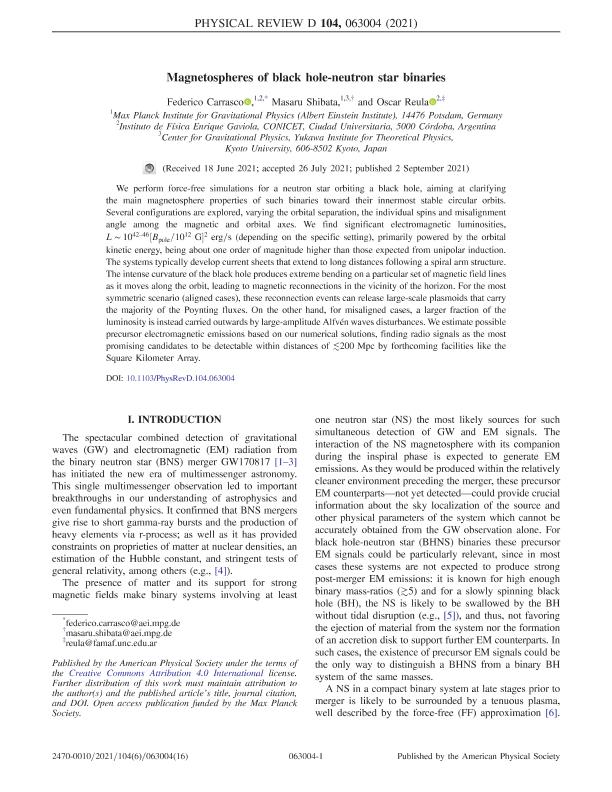Mostrar el registro sencillo del ítem
dc.contributor.author
Carrasco, Federico León

dc.contributor.author
Shibata, Masaru
dc.contributor.author
Reula, Oscar Alejandro

dc.date.available
2023-01-20T13:29:04Z
dc.date.issued
2021-09
dc.identifier.citation
Carrasco, Federico León; Shibata, Masaru; Reula, Oscar Alejandro; Magnetospheres of black hole-neutron star binaries; American Physical Society; Physical Review D; 104; 6; 9-2021; 1-16
dc.identifier.issn
2470-0010
dc.identifier.uri
http://hdl.handle.net/11336/185112
dc.description.abstract
We perform force-free simulations for a neutron star orbiting a black hole, aiming at clarifying the main magnetosphere properties of such binaries toward their innermost stable circular orbits. Several configurations are explored, varying the orbital separation, the individual spins and misalignment angle among the magnetic and orbital axes. We find significant electromagnetic luminosities, L∼1042-46[Bpole/1012 G]2 erg/s (depending on the specific setting), primarily powered by the orbital kinetic energy, being about one order of magnitude higher than those expected from unipolar induction. The systems typically develop current sheets that extend to long distances following a spiral arm structure. The intense curvature of the black hole produces extreme bending on a particular set of magnetic field lines as it moves along the orbit, leading to magnetic reconnections in the vicinity of the horizon. For the most symmetric scenario (aligned cases), these reconnection events can release large-scale plasmoids that carry the majority of the Poynting fluxes. On the other hand, for misaligned cases, a larger fraction of the luminosity is instead carried outwards by large-amplitude Alfvén waves disturbances. We estimate possible precursor electromagnetic emissions based on our numerical solutions, finding radio signals as the most promising candidates to be detectable within distances of ≲200 Mpc by forthcoming facilities like the Square Kilometer Array.
dc.format
application/pdf
dc.language.iso
eng
dc.publisher
American Physical Society

dc.rights
info:eu-repo/semantics/openAccess
dc.rights.uri
https://creativecommons.org/licenses/by-nc-sa/2.5/ar/
dc.subject
Binaries
dc.subject
Black hole
dc.subject
Neutron star
dc.subject
Force-free
dc.subject.classification
Física de los Fluidos y Plasma

dc.subject.classification
Ciencias Físicas

dc.subject.classification
CIENCIAS NATURALES Y EXACTAS

dc.title
Magnetospheres of black hole-neutron star binaries
dc.type
info:eu-repo/semantics/article
dc.type
info:ar-repo/semantics/artículo
dc.type
info:eu-repo/semantics/publishedVersion
dc.date.updated
2022-09-22T10:33:23Z
dc.identifier.eissn
2470-0029
dc.journal.volume
104
dc.journal.number
6
dc.journal.pagination
1-16
dc.journal.pais
Estados Unidos

dc.description.fil
Fil: Carrasco, Federico León. Consejo Nacional de Investigaciones Científicas y Técnicas. Centro Científico Tecnológico Conicet - Córdoba. Instituto de Física Enrique Gaviola. Universidad Nacional de Córdoba. Instituto de Física Enrique Gaviola; Argentina
dc.description.fil
Fil: Shibata, Masaru. Max Planck Institute For Gravitational Physics ; Alemania. Kyoto University; Japón
dc.description.fil
Fil: Reula, Oscar Alejandro. Consejo Nacional de Investigaciones Científicas y Técnicas. Centro Científico Tecnológico Conicet - Córdoba. Instituto de Física Enrique Gaviola. Universidad Nacional de Córdoba. Instituto de Física Enrique Gaviola; Argentina
dc.journal.title
Physical Review D
dc.relation.alternativeid
info:eu-repo/semantics/altIdentifier/url/https://journals.aps.org/prd/abstract/10.1103/PhysRevD.104.063004
dc.relation.alternativeid
info:eu-repo/semantics/altIdentifier/doi/http://dx.doi.org/10.1103/PhysRevD.104.063004
dc.relation.alternativeid
info:eu-repo/semantics/altIdentifier/url/https://arxiv.org/abs/2106.09081
Archivos asociados
